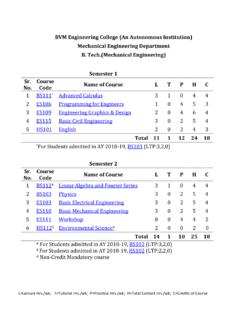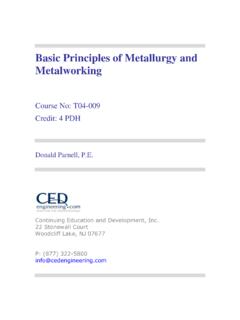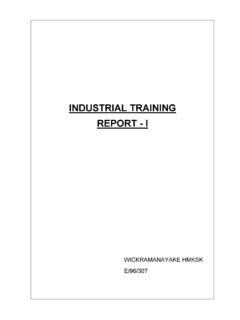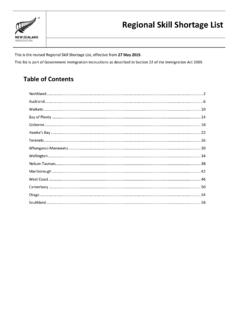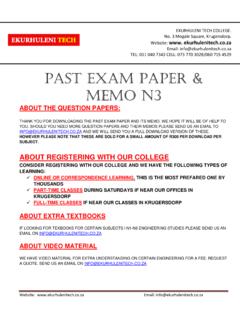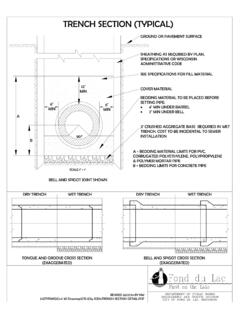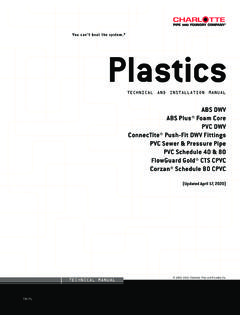Transcription of Corrosion testing techniques and ... - Stainless Foundry
1 [ Corrosion testing ] Stainless Steel World December 2018 1 There are endless options for surface finishes and conditions for metal products. Chemical coatings, films and paints are commonly applied to metal parts. The many surface preparation and coating options range from; blasting and polishing, to pickling, passivation and plating. But remember, application of any type of coating adds another level of complexity to the finishing process. So how do you know if your coating, plating or application is going to hold up over time and exposure to the elements before going into production? Environmental simulation, and/or accelerated Corrosion testing , is the perfect technique to determine durability of your products. By Michael Porfiliio, Director, of Quality, Stainless Foundry & engineering , Inc., USA Corrosion costsThe products of Corrosion that are at times an aesthetic annoyance cannot be compared to the potential catastrophic failure to many Corrosion modes.
2 There are numerous hidden costs of Corrosion to structures, equipment, bridges, proactive coatings, specialty materials, cathodes, anodes, or other manufactured parts are just some of the items that suffer the effects of price of Corrosion damage is staggering. A 2016 global study by NACE International puts the global cost of Corrosion is estimated to be $ USD trillion, which is equivalent to of the global Gross Domestic Product (GDP) in 2013 1. By using available Corrosion control practices, it is estimated that a savings of 15% to 35% of the cost of Corrosion could be realized; between $375 to $875 billion USD annually on a on a global basis could be saved 1. See table coatings industry is experiencing pressure from environmentalist groups, corporate sustainability programs and individuals to produce greener products. These greener offerings in the long run will in general will be the future of coating processing but at what cost if they don t perform.
3 Environmentally friendlier coatings generally have less Corrosion resistance over the lifetime of the coating or finish. This has left the industry, in some situations, struggling to come up with new alternative friendlier counterparts that have long term performance reducing costs and offering sustainability. Salt spray and humidity testingTests such as neutral salt spray testing (NSS) and humidity testing can help a manufacturer or end user determine the effectiveness and reliability of their coating/finishing process. By examining test specimens throughout the duration of the test, obviously surface effects are noticeable sometimes within a single day or two, preventing expensive and time consuming rework and recalls. The comparison to an unfinished or control specimens will help to determine the best surface finish for the intended application. At times no surface finish will be acceptable and a new material Corrosion testing techniques and evaluation practices used in industryTable Cost of Corrosion FiguresGlobal Cost of Corrosion (CoC) by Sector (Billion USD) NACE Impact Study1 Economic RegionsAgriculture CoC USD billionIndustry COC USD billionServices COC USD billionTotal COC USD billionTotal GDP USD billionCOC % GDPU nited , , , , , , , Asian Tigers + , of the , , [ Corrosion testing ]2 Stainless Steel World December 2018 may be the only are many specifications and standards written to direct how testing , and equally important, to evaluate the results of your tests.
4 The most common specifications for performing a NSS test are ASTM B117 and ISO 9227, which outline the test conditions required for the neutral salt spray testing . These specifications unify the testing parameters across the globe in the efforts to evaluate the effectiveness of paints, coatings and specifications unify the test parameters worldwide in order to evaluate the effectiveness of paints, coatings and finishes. In this test, an atmosphere of 5% solution of Sodium Chloride is atomized and introduced at a constant rate throughout a sealed chamber. Test specimens are inclined and placed in the polyethylene lined cabinet so that the test is parallel to the primary direction of flow of the sodium chloride mist. The mist wets the surface, and the excess solution runs off into the bottom of the cabinet. Humidity testing is another measurement of the effectiveness of the Corrosion resistance properties of a metal part.
5 This test can be performed in many ways. The first takes place in an unused NSS cabinet by sampling turning off the salt solution flow and plugging the drain. The second test takes place in an environmental simulation cabinet specifically designed for this type of test. The requirements for this test can be specified by a manufacturer s specification or in an ASTM specification publication such as ASTM D2247 and ISO 16961. These types of tests assist in evaluating primarily paints and their tendencies to bubble and blister. Acceptance criteria s for the test results are generally customer iron detection tests and evaluationsThe above two types of evaluations (NSS and environmental), cabinet Corrosion testing can also be very effective as free iron detection tests. Free iron testing is an excellent predictor of Corrosion resistance properties and surface finish success. Locations on a casting or finished part, which are rich in free iron, can become epicenters for Corrosion while in service or inventory.
6 In most cases, free iron tests can be done via salt spray testing in about two hours or in a humidity chamber in about 24 hours. These different combinations of test media and hours of exposure have led to a host of different conclusions for manufacturers and end users. The most important element is the cost effectiveness of coating and surface finishes vs. Corrosion addition to these two cabinet style tests, another procedure that can effectively detect free iron is a potassium ferricyanide nitric acid (Ferroxyl) test, in accordance with MIL-STD-735 and ASTM A380. The Ferroxyl test will illuminate even the lowest levels of iron contamination. In this test a reaction with the chemicals in the test solution yields a chemical reaction in the form of a bluish coloration, demonstrating the presence of free iron. It is a very sensitive the testing has begun, the challenge becomes the evaluation of the constantly changing surfaces of interest.
7 Sometimes it is helpful to add a point of certain failure to the test specimen, or scribe, to see how bad a failure becomes if it should occur via damage or deficiency of the coating. There are many evaluation procedures such as ASTM D610, D714 and D1654 that oversee the evaluation of the test specimens. These specifications use numerical values to evaluate the severity of the Corrosion , blistering and/or creep. These laboratory type tests have one goal in common: to assist the surface preparation industries, evaluate the efficacy of their coating material and/or process. Corrosion testing can assist industries from epoxy powder coating companies to chemical coating operations to zinc/cadmium/chrome plating providers, and everyone in between. The ultimate goal in applying a coating or perform surface treatments is to protect surfaces providing the highest quality product with the least amount of overhead in order to yield maximum Corrosion testing conceptsAccelerated Corrosion testing allows base material verification prior to final application of surface treatments such as plating or polishing.
8 Unwanted Corrosion in Stainless steels and other related alloys is of significant concern and consideration in their engineering and function. Rough surface finish, elevated temperatures and corrosive environments encountered in service can accelerated Corrosion and lead to early failure in materials as well as stained surface different forms of Corrosion are commonly encountered in service, and many can be strongly influenced by the heat treatment process. Fortunately, there are many types of standardized test methods and evaluations, which seek to qualify materials and quantify the rates Corrosion that a metal alloy may experience. Some examples are noted Corrosion is a localized form of Corrosion found in Stainless steels and other related alloys, which does not typically experience uniform Corrosion . Pitting Corrosion is typically caused by the breakdown of the passive surface layer and results in small zones of corroded pits.
9 These pits can act as sites of crack initiation and are detrimental to a materials performance and Corrosion (IGC) in Stainless steel generally is associated with a precipitated inter-metallic phase found at the grain boundaries of a material. For example chromium carbide precipitation at the grain boundaries of an alloy can deplete the surrounding areas of Corrosion inhibiting chromium. In the Table Intergranular Corrosion Coupon Cast Stainless SteelTested Corrosion CouponCorrosion Test CommentsIntergranular Corrosion coupon tested in accordance with ASTMA262, Practice B(120 hour boiled in ferric sulfate sulfuric acid). Sample exhibits an acceptable mass loss of grams and a mass loss rate of mils/yr.[ Corrosion testing ] Stainless Steel World December 2018 3presence of a corrosive environment, these grain boundaries are preferentially attacked and are subsequently Corrosion cracking (SCC) is another form of Corrosion that can cause normally ductile materials to fail prematurely in a brittle manner.
10 When a material is both stressed (especially at elevated temperatures) and also exposed to a corrosive environment, the grain boundaries can be attacked and the materials mechanical properties can be compromised. SCC is very alloy specific in that certain alloys may only experience SCC in the presence of specific chemical environments. Austenitic Stainless steels in particular are susceptible to SCC in the presence of chlorides. Sensitizing heat treatments in Stainless steel can aggravate problems associated with intergranular Corrosion (sensitization is a process in which the material is heated to a temperature in which chromium carbides for example can precipitate out of solution at a grain boundaries and create a chromium depleted region which adversely effects Corrosion resistance). Austenitic Stainless steels are susceptible to sensitization after heating to roughly 500 C to 800 C. The addition of carbide stabilizing elements such as niobium or titanium can help to ameliorate the problem, however, processes such as welding a susceptible material can still detrimentally affect its microstructural integrity.

